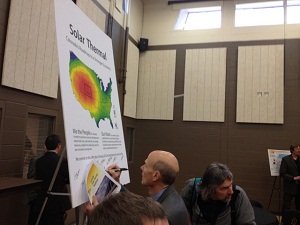Solar thermal in Colorado could create 24,000 jobs, generate $1 billion in annual revenue
 Colorado has the highest solar thermal resources in the U.S. Resources which could create 24,000 jobs, generating $1 billion in annual state revenue by 2050 and becoming an international heavyweight—if the state plays its cards right.
Colorado has the highest solar thermal resources in the U.S. Resources which could create 24,000 jobs, generating $1 billion in annual state revenue by 2050 and becoming an international heavyweight—if the state plays its cards right.
Making that happen is the goal of STAC, the newly forged Solar Thermal Alliance of Colorado, created by an umbrella of organizations in the state, including Colorado Solar Energy Industries Association (COSEIA), Colorado Renewable Energy Society (CRES), Colorado Environmental Coalition and other organizations.
The group held a meeting on Jan.24, attended by State Reps. Max Tyler and Randy Fischer, both Democrats, to announce its goals and the Colorado Solar Thermal Roadmap, which will help the state become an international leader in the field.
Solar thermal technologies can heat and cool homes and produce electricity, all of which help to reduce dependence on fossil fuels.
“Solar thermal technology performs better in Colorado than in any other state in the nation. We have intense sunshine here and wide temperature swings between the daytime temperatures and the nighttime temperatures. We also have relatively cold groundwater and a high heating load,” said COSEIA Executive Director Neal Lurie. “You combine those and other factors together, and Colorado becomes the national bull’s eye of solar thermal performance. We need to take advantage of that unique competitive position in Colorado to generate jobs and grow economic development all across the state.”
Capitalizing on that opportunity will help advance the state’s economy, according to CRES Executive Director Tony Frank.
“Our business is to make Colorado a business leader in solar thermal adoption, installation, manufacturing, research and development,” he said. “The roadmap is broke into three sections. First, it goes over the marketplace in Colorado. Second, it lays out the goals of the solar thermal road map. Finally, it lays out a strategy for how to get there.”
That three-pronged strategy will be key, Frank said. It includes raising awareness of solar thermal technologies—many of whom are only familiar with photovoltaics; developing financial mechanisms like loans and other financing to support projects; leveling state policy to include and encourage solar thermal; and solving impediments to adoption, which includes reducing barriers to access, and creating consistent zoning processes across the state.
As the group moves forward with the roadmap, it will look to the experience of other countries with significant solar thermal projects.
“There are a lot of countries we're looking at for lessons learned there. One out of 10 cups of tea in China are heated with energy from the sun, using solar thermal technology,” Lurie said. “Israel is a major player in solar thermal. It is remarkable that you have literally tens of millions of solar thermal homeowners all over across the world. There's an opportunity here by being able to look at what's happening in those countries like India and China and Germany, certainly.”
The state already is on its way, with the equivalent of 150 megawatts of solar thermal projects already installed and solar thermal concentrating solar power companies in the state.
“We have two of the leading concentrating solar power companies, Abengoa Solar as well as Skyfuel,” Lurie said. “We think that we've started to build a manufacturing cluster in Colorado that we think highlights the high-caliber workforce we have here, which we can use to attract more.”
It just needs some extra effort from groups like STAC to push forward.
Pictured: Rep. Fischer signing onto the STAC agreement. Photo: Chris Meehan / Clean Energy Authority.



